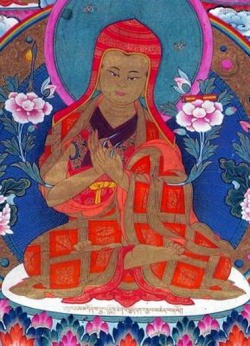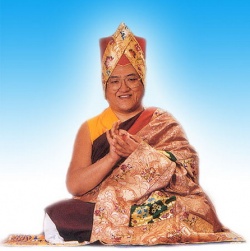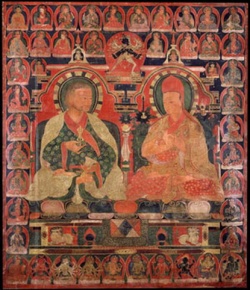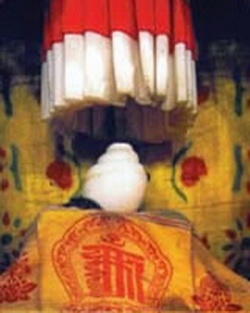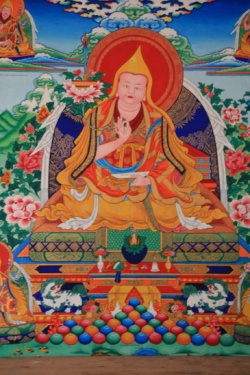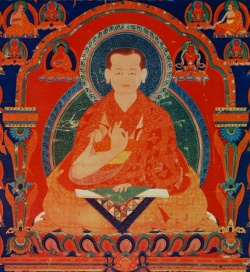Difference between revisions of "The Sakya lineage"
(Created page with "<poem> His Holiness the Sakya Trizin is the 41st patriarch of the Sakya school and is a direct descendent of the Khon lineage. "Sakya Trizin" means the t...") |
|||
| (4 intermediate revisions by 2 users not shown) | |||
| Line 1: | Line 1: | ||
| + | [[File:Sakya_Pandita_Kunga_Gyaltsen.JPG|thumb|250px|]] | ||
<poem> | <poem> | ||
[[His Holiness]] the [[Sakya Trizin]] is the [[41st patriarch of the Sakya school]] and is a direct descendent of the [[Khon lineage]]. "[[Sakya Trizin]]" means the [[throneholder of Sakya]]. | [[His Holiness]] the [[Sakya Trizin]] is the [[41st patriarch of the Sakya school]] and is a direct descendent of the [[Khon lineage]]. "[[Sakya Trizin]]" means the [[throneholder of Sakya]]. | ||
The [[Khon family lineage]] | The [[Khon family lineage]] | ||
| − | + | [[File:SakyaPandita0.jpg|thumb|250px|]] | |
The [[Khon family]] has three supreme titles: | The [[Khon family]] has three supreme titles: | ||
| − | + | [[File:Sakyatrizin.jpg|thumb|250px|]] | |
[[Lha-Rig]] - [[celestial family]] | [[Lha-Rig]] - [[celestial family]] | ||
[[Khon]] - [[subduer of ignorance]] | [[Khon]] - [[subduer of ignorance]] | ||
[[Sakya]] | [[Sakya]] | ||
| − | + | [[File:Sakya4pandita.jpg|thumb|250px|]] | |
[[Celestial family]] | [[Celestial family]] | ||
| − | + | [[File:Conch shell,4.jpg|thumb|250px|]] | |
The first supreme title of the [[Khon family]] is [[Lha-Rig]] meaning '[[celestial family]]'. From the [[Rupadhatu]][[ heavenly realm]] arose three [[manifestations]] of [[Manjushri]]. The second of these three was [[Yuring]] who had seven sons. The youngest son was grandfather to [[Yapang Kye]] abiding within the [[luminosity]] of this [[celestial realm]]. | The first supreme title of the [[Khon family]] is [[Lha-Rig]] meaning '[[celestial family]]'. From the [[Rupadhatu]][[ heavenly realm]] arose three [[manifestations]] of [[Manjushri]]. The second of these three was [[Yuring]] who had seven sons. The youngest son was grandfather to [[Yapang Kye]] abiding within the [[luminosity]] of this [[celestial realm]]. | ||
| − | + | [[File:Phagpa lha 03.jpg|thumb|250px|]] | |
[[Subduer of ignorance]] | [[Subduer of ignorance]] | ||
| − | + | [[File:Rongton Sheja-kunrig.jpg|thumb|250px|]] | |
The second title was received after [[Yapang Kye]] subdued the [[raksha]], [[Kya Ring]] and married his wife, also a [[raksha]]. Their son was given the title [[Khon]] because of the union of a [[celestial being]] and a [[raksha]]. Thus, [[Khon]] means '[[subduer of ignorance]]'. Each of these [[precious]] [[Khon lineage]] holders showed many great [[signs]] of {{Wiki|holy}} [[beings]], such as a [[dharmachakra]] in the palms of their hands. | The second title was received after [[Yapang Kye]] subdued the [[raksha]], [[Kya Ring]] and married his wife, also a [[raksha]]. Their son was given the title [[Khon]] because of the union of a [[celestial being]] and a [[raksha]]. Thus, [[Khon]] means '[[subduer of ignorance]]'. Each of these [[precious]] [[Khon lineage]] holders showed many great [[signs]] of {{Wiki|holy}} [[beings]], such as a [[dharmachakra]] in the palms of their hands. | ||
| Line 22: | Line 23: | ||
Before he passed into [[parinirvana]], [[Chen Lotsawa]] advised his student to receive the remaining teachings from [[Drogmi Lotsawa]] himself. [[Khon Konchog Gyalpo]] met [[Drogmi Lotsawa]] and received all the profound [[tantric teachings]] from him. He also received many teachings from great [[masters]] such as [[Mal Lotsawa]] and [[Bari Lotsawa]] and others, and so became an [[owner]] of the teachings. | Before he passed into [[parinirvana]], [[Chen Lotsawa]] advised his student to receive the remaining teachings from [[Drogmi Lotsawa]] himself. [[Khon Konchog Gyalpo]] met [[Drogmi Lotsawa]] and received all the profound [[tantric teachings]] from him. He also received many teachings from great [[masters]] such as [[Mal Lotsawa]] and [[Bari Lotsawa]] and others, and so became an [[owner]] of the teachings. | ||
| − | |||
| − | |||
| − | At that [[time]] [[Atisha]] (981-1054) came to [[Tibet]] in 1042. He saw many great [[signs]] that indicated that in future many great [[activities]] would be accomplished by two Mahakalas. He saw the "[[grey earth]]" (SA KYA) and performed many [[prostrations]] and made elaborate [[offerings]] at that place. He saw the [[letter]] HRI and seven DHI and one HUM syllables. [[Atisha]] prophesied that one [[Avalokitesvara]] [[emanation]], seven [[Manjushri]] [[emanations]] and one [[Vajrapani]] [[emanation]] would come to [[benefit]] many [[sentient beings]]. | + | [[Khon Konchog Gyalpo]] built a small [[monastery]] and began [[teaching]], giving profound teachings. His [[noble]] [[activities]] increased and he later established the seat of the glorious [[Sakya lineage]], as was prophesied within the [[Manjushri root Tantra]], which begins with the syllables SA and KA. |
| + | |||
| + | At that [[time]] [[Atisha]] (981-1054) came to [[Tibet]] in 1042. He saw many great [[signs]] that indicated that in future many great [[activities]] would be accomplished by two [[Mahakalas]]. He saw the "[[grey earth]]" (SA KYA) and performed many [[prostrations]] and made elaborate [[offerings]] at that place. He saw the [[letter]] HRI and seven DHI and one HUM syllables. [[Atisha]] prophesied that one [[Avalokitesvara]] [[emanation]], seven [[Manjushri]] [[emanations]] and one [[Vajrapani]] [[emanation]] would come to [[benefit]] many [[sentient beings]]. | ||
[[Sakya]] | [[Sakya]] | ||
| Line 31: | Line 32: | ||
[[Sakya Monastery]], [[Tibet]] | [[Sakya Monastery]], [[Tibet]] | ||
| − | [[Khon | + | [[Khon Konchog Gyalpo]] was living in the vicinity and while walking he saw many [[auspicious]] [[signs]], such as white [[earth]] that was glowing and a [[river]] flowed on the right side, etc. It [[caused]] him to think that if he established a [[monastery]] at that place, it would greatly help many [[beings]]. He received permission from his elder brother and acquired land to establish a [[monastery]], which was named [[SAKYA]]. |
From that [[time]] on both the [[monastery]] and the family took on the [[name]] [[Sakya]], which is the third of the titles by which the [[lineage]] is known. This [[lineage]] spread widely in [[Tibet]] and later into [[China]], [[Mongolia]] and more recently to all parts of the [[world]]. | From that [[time]] on both the [[monastery]] and the family took on the [[name]] [[Sakya]], which is the third of the titles by which the [[lineage]] is known. This [[lineage]] spread widely in [[Tibet]] and later into [[China]], [[Mongolia]] and more recently to all parts of the [[world]]. | ||
| − | The five founders of the [[Sakya]] [[lineage]] included the [[noble]] son of [[Khon | + | The five founders of the [[Sakya]] [[lineage]] included the [[noble]] son of [[Khon Konchog Gyalpo]], [[Sachen Kunga Nyingpo]] (1092-1158), who was the [[emanation]] of [[Avalokitesvara]]. [[Sonam Tsenmo]] (1142-1182), [[Dragpa Gyaltsen]] (1147-1216), [[Sakya Pandita]] (1182-1251) and [[Chogyal Phagpa]] (1235-1280) are the other four founders. |
[[Sakya Pandita]] | [[Sakya Pandita]] | ||
| Line 41: | Line 42: | ||
At the [[time]] of [[Sakya Pandita's]] {{Wiki|conception}}, deep [[Samadhi]] arose within his mother and later she had many other [[signs]] of giving [[birth]] to a [[great being]]. At the [[time]] of [[birth]] a great [[light]] filled the entire [[space]] and many [[dakinis]] appeared, showering him with [[flowers]]. As a toddler his mother [[thought]] he was {{Wiki|speaking}} childish gibberish and worried that he may have {{Wiki|obstacles}}, but his father discovered that he was able to speak the [[Tibetan]] and [[Sanskrit]] [[languages]]. Not only that, he spontaneously drew [[Sanskrit]] nouns and consonants and could read them. | At the [[time]] of [[Sakya Pandita's]] {{Wiki|conception}}, deep [[Samadhi]] arose within his mother and later she had many other [[signs]] of giving [[birth]] to a [[great being]]. At the [[time]] of [[birth]] a great [[light]] filled the entire [[space]] and many [[dakinis]] appeared, showering him with [[flowers]]. As a toddler his mother [[thought]] he was {{Wiki|speaking}} childish gibberish and worried that he may have {{Wiki|obstacles}}, but his father discovered that he was able to speak the [[Tibetan]] and [[Sanskrit]] [[languages]]. Not only that, he spontaneously drew [[Sanskrit]] nouns and consonants and could read them. | ||
| − | As he grew he was able to understand difficult points of study without having been tutored in them. At that [[time]] there were many great [[scholars]] in [[Tibet]], but only [[Sakya Pandita]] was the first to accomplish all of the five major {{Wiki|sciences}} ([[art]], [[medicine]], [[Sanskrit]] {{Wiki|grammar}}, [[logic]] and [[Buddhist doctrine]]) and five minor {{Wiki|sciences}} ([[poetry]], drama, [[astrology]], dance and [[language]]). He studied with three great [[Indian]] [[pandits]] ([[Danasila]], Sugatashri and Samgashri) for almost a decade. | + | As he grew he was able to understand difficult points of study without having been tutored in them. At that [[time]] there were many great [[scholars]] in [[Tibet]], but only [[Sakya Pandita]] was the first to accomplish all of the five major {{Wiki|sciences}} ([[art]], [[medicine]], [[Sanskrit]] {{Wiki|grammar}}, [[logic]] and [[Buddhist doctrine]]) and five minor {{Wiki|sciences}} ([[poetry]], drama, [[astrology]], dance and [[language]]). He studied with three great [[Indian]] [[pandits]] ([[Danasila]], [[Sugatashri]] and [[Samgashri]]) for almost a decade. |
| − | He received the title [[Pandita]] from [[Shakya]] | + | He received the title [[Pandita]] from [[Shakya Shri Badhra]] (1140-1225) and so was the first [[Tibetan]] to have received the [[highest]] {{Wiki|honor}} from an [[Indian]] [[master]]. He began [[teaching]] at the age of nine and was known for his {{Wiki|abilities}} to teach simply, unmistakenly and precisely, and he continued without interruption until the age of seventy. He was able to teach [[Buddhist]] and non-[[Buddhist]] [[philosophy]] and the [[five sciences]] according to the capacity and needs of his students. |
| − | Harinanda was a great [[Hindu]] logician famous in the [[east]] and [[west]] of [[India]] who came to Kyirong with five other great [[Hindu]] [[pandits]] to seek out [[Sakya Pandita]]. On meeting [[Sakya Pandita]] they did not show [[respect]] through [[prostrations]] but merely recited a | + | [[Harinanda]] was a great [[Hindu]] logician famous in the [[east]] and [[west]] of [[India]] who came to [[Kyirong]] with five other great [[Hindu]] [[pandits]] to seek out [[Sakya Pandita]]. On meeting [[Sakya Pandita]] they did not show [[respect]] through [[prostrations]] but merely recited a verse of a [[tantra]] before being seated near [[Sakya Pandita]]. They claimed that they had a [[pure]] [[lineage]] of {{Wiki|Rishis}} traceable directly to [[Brahma]] and so there was no need to [[take refuge]] in the [[triple gem]]. [[Sakya Pandita]] responded by reciting [[Buddhist]] verses that developed into a [[debate]] that helped them to completely cleanse the stains of their [[wrong views]]. [[Harinanda]] abandoned his former [[beliefs]] and took [[ordination]] with [[Sakya Pandita]]. [[Harinanda]] cut off his ascetic's topknot and this can still be seen at the Great [[Sakya monastery]] in [[Tibet]]. The consequence of this encounter was that [[Hinduism]] never took hold in [[Tibet]]. |
| − | [[Sakya Pandita]] gained the {{Wiki|realisation}} of [[fearlessness]] of all [[knowledge]]. In order to show the [[path of liberation]] to all [[beings]] throughout future generations, he composed many commentaries of the [[sutras]] such as "The [[Sages]] | + | [[Sakya Pandita]] gained the {{Wiki|realisation}} of [[fearlessness]] of all [[knowledge]]. In order to show the [[path of liberation]] to all [[beings]] throughout future generations, he composed many commentaries of the [[sutras]] such as "The [[Sages Inten]]", "The [[Perfect Differentiation of the Three Vows]]", "The [[Treasure of Reasoning]]" and many others. |
[[Sakya Pandita]] was the first [[Tibetan]] born [[master]] capable of translating texts from [[Sanskrit]] without reliance on [[Indian]] [[masters]]. His works were translated from [[Tibetan]] back into [[Sanskrit]] and were praised by the [[Indian]] [[pandits]]. He was the first [[Tibetan]] [[master]] to take the [[Vajrayana teachings]] out of [[Tibet]] to introduce them to [[Mongolia]] and [[China]]. [[Sakya Pandita]] became famous throughout [[Tibet]], [[Mongolia]], [[China]] and [[India]] and was considered to be a {{Wiki|real}} [[emanation]] of [[Manjushri]] in [[human]] [[form]]. | [[Sakya Pandita]] was the first [[Tibetan]] born [[master]] capable of translating texts from [[Sanskrit]] without reliance on [[Indian]] [[masters]]. His works were translated from [[Tibetan]] back into [[Sanskrit]] and were praised by the [[Indian]] [[pandits]]. He was the first [[Tibetan]] [[master]] to take the [[Vajrayana teachings]] out of [[Tibet]] to introduce them to [[Mongolia]] and [[China]]. [[Sakya Pandita]] became famous throughout [[Tibet]], [[Mongolia]], [[China]] and [[India]] and was considered to be a {{Wiki|real}} [[emanation]] of [[Manjushri]] in [[human]] [[form]]. | ||
| − | [[Sakya Pandita]] had [[Wikipedia:Authenticity|authentic]] visions of the [[deity]] as a [[person]]. Whist receiving [[guru yoga]] [[initiation]] from his [[guru]] [[Dragpa Gyaltsen]], he saw his [[guru]] was the [[embodiment]] of | + | [[Sakya Pandita]] had [[Wikipedia:Authenticity|authentic]] visions of the [[deity]] as a [[person]]. Whist receiving [[guru yoga]] [[initiation]] from his [[guru]] [[Dragpa Gyaltsen]], he saw his [[guru]] was the [[embodiment]] of all the Buddhas in the [[form]] of [[Manjushri]]. At that moment he perfectly understood the [[nature]] of all [[phenomena]] and gained [[infinite]] {{Wiki|realisation}} of deep [[samadhi]]. |
For the sake of [[sentient beings]] he [[manifested]] the [[appearance]] of {{Wiki|illness}}. At that [[time]], [[Shantideva]] appeared directly to him, giving him teachings on [[cause and effect]]; [[Nagarjuna]] gave teachings on the four great [[seals]]; [[Manjushri]] [[offered]] [[Sakya Pandita]] to be his [[Wikipedia:tutelary deity|tutelary deity]] throughout all of his lifetimes; and [[Avalokitesvara]] touched [[Sakya Pandita]] with his hand [[healing]] him of all discomfort and [[suffering]]. There were many other visions. [[Sakya Pandita]] also demonstrated unobscured clairvoyance in order to help many other [[beings]]. | For the sake of [[sentient beings]] he [[manifested]] the [[appearance]] of {{Wiki|illness}}. At that [[time]], [[Shantideva]] appeared directly to him, giving him teachings on [[cause and effect]]; [[Nagarjuna]] gave teachings on the four great [[seals]]; [[Manjushri]] [[offered]] [[Sakya Pandita]] to be his [[Wikipedia:tutelary deity|tutelary deity]] throughout all of his lifetimes; and [[Avalokitesvara]] touched [[Sakya Pandita]] with his hand [[healing]] him of all discomfort and [[suffering]]. There were many other visions. [[Sakya Pandita]] also demonstrated unobscured clairvoyance in order to help many other [[beings]]. | ||
| Line 57: | Line 58: | ||
At that [[time]] the most powerful {{Wiki|political}} leaders became his [[disciples]] as well as non-humans such as the [[king]] of the [[Nagas]] and the [[king]] of the [[Bhutas]]. | At that [[time]] the most powerful {{Wiki|political}} leaders became his [[disciples]] as well as non-humans such as the [[king]] of the [[Nagas]] and the [[king]] of the [[Bhutas]]. | ||
| − | [[Sakya Pandita]] received an invitation from Goden | + | [[Sakya Pandita]] received an invitation from [[Wikipedia:Godan Khan|Goden Khan]] to go to [[Mongolia]]. He then remembered a [[prophesy]] of [[Dragpa Gyaltsen]] made years earlier. [[Dragpa Gyaltsen]] had prophesied, "Within your [[lifetime]] a [[person]] representing [[people]] wearing shoes with the shape of a pig's {{Wiki|nose}}, colourful hats and {{Wiki|speaking}} a different [[language]] will come to invite you to their land. At that [[time]] you must accept this invitation without hesitation for the [[benefit]] of [[sentient beings]] and the [[Buddhadharma]]." |
| − | Accompanied by his two nephews he departed from [[Sakya monastery]] in 1244. On the way to [[China]] he gave many teachings and [[initiations]] and eventually arrived at Ling Chui in 1247, where he met Goden | + | Accompanied by his two nephews he departed from [[Sakya monastery]] in 1244. On the way to [[China]] he gave many teachings and [[initiations]] and eventually arrived at Ling Chui in 1247, where he met [[Wikipedia:Godan Khan|Goden Khan]]. The [[emperor]] was deeply impressed by [[Sakya Pandita's]] [[knowledge]] and after many discussions of [[worldly]] and [[spiritual]] matters, the Great {{Wiki|Khan}} ordered changes to protocols. In future, the [[guru]] would be seated in the [[highest]] place and then the [[monastic]] [[Sangha]], with the lay {{Wiki|community}} in the lowest position. |
| − | Goden | + | [[Wikipedia:Godan Khan|Goden Khan]] and the entire court received many teachings on the vast and profound [[Mahayana]] and [[Tantrayana]] and so the whole country began to make [[offerings]] to the [[Triple Gem]], abandon [[non-virtuous]] [[deeds]] and integrate the [[Buddhadharma]] into their [[lives]]. |
Through the [[activities]] of his [[body]] [[speech]] and [[mind]] [[Sakya Pandita]] was able to help countless [[sentient beings]] up to his [[parinirvana]] one early morning, at the age of seventy, in 1251. The teachings of [[Sakya Pandita]] spread like the rays of the {{Wiki|sun}} throughout [[Tibet]], [[China]] and [[Mongolia]] and produced many great [[disciples]] as numerous as stars at night [[time]]. Among these were his [[heart]] [[disciples]], his younger brother [[Sonam Gyaltsen]] and his nephew [[Chogyal Phagpa]], who became his successor. | Through the [[activities]] of his [[body]] [[speech]] and [[mind]] [[Sakya Pandita]] was able to help countless [[sentient beings]] up to his [[parinirvana]] one early morning, at the age of seventy, in 1251. The teachings of [[Sakya Pandita]] spread like the rays of the {{Wiki|sun}} throughout [[Tibet]], [[China]] and [[Mongolia]] and produced many great [[disciples]] as numerous as stars at night [[time]]. Among these were his [[heart]] [[disciples]], his younger brother [[Sonam Gyaltsen]] and his nephew [[Chogyal Phagpa]], who became his successor. | ||
| + | |||
[[Chogyal Phagpa]] | [[Chogyal Phagpa]] | ||
| − | Many great [[signs]] were also seen at the [[time]] of [[Chogyal | + | Many great [[signs]] were also seen at the [[time]] of [[Chogyal Phagpa's]] [[birth]]. He was able to remember many past [[lives]]. Even at the age of three he was able to recite many lengthy [[sadhanas]] and by the age of eight knew all the [[Jataka tales]] (the previous [[lives]] of the [[Buddha]]) by [[heart]]. He gave public teachings at a very young age and in this way subdued the [[pride]] of the elder [[scholars]], and so was given the [[name]] [[Phagpa]] ([[Arya]], or {{Wiki|holy}} being). By the age of ten he received the [[monk's]] [[vows]] from his uncle, [[Sakya Pandita]], in front of the [[Jowo]] statue at [[Lhasa]]. |
| Line 76: | Line 78: | ||
[[Sakya Pandita]] also [[offered]] a [[begging bowl]] and gave {{Wiki|responsibility}} for the care of all of his students to [[Chogyal Phagpa]], reminding him that in previous [[lives]] [[Chogyal Phagpa]] had pledged to serve the [[Buddhadharma]] and help all [[sentient beings]]. Soon after, [[Sakya Pandita]] passed into [[parinirvana]]. | [[Sakya Pandita]] also [[offered]] a [[begging bowl]] and gave {{Wiki|responsibility}} for the care of all of his students to [[Chogyal Phagpa]], reminding him that in previous [[lives]] [[Chogyal Phagpa]] had pledged to serve the [[Buddhadharma]] and help all [[sentient beings]]. Soon after, [[Sakya Pandita]] passed into [[parinirvana]]. | ||
| − | When [[Chogyal Phagpa]] was nineteen he was invited to [[Mongolia]] by the [[emperor]], {{Wiki|Kublai Khan}}. He performed many [[miracles]] such as displaying the | + | When [[Chogyal Phagpa]] was nineteen he was invited to [[Mongolia]] by the [[emperor]], {{Wiki|Kublai Khan}}. He performed many [[miracles]] such as displaying the [[five dhyani Buddhas]]. As a consequence the [[emperor]] and his court developed unshakeable [[faith]] and [[devotion]] to [[Chogyal Phagpa]]. The [[Vajrayana]] was first introduced to [[Mongolia]] and [[China]] when [[Chogyal Phagpa]] bestowed the [[Hevajra]] [[initiation]] on twenty-five [[people]] led by the [[emperor]] and his [[Wikipedia:Queen consort|queen]] three times. |
For each [[initiation]], the [[emperor]] made increasingly more generous [[offerings]] to [[Chogyal Phagpa]] until after the third [[initiation]], the [[emperor]] [[offered]] all of [[Tibet]] to him. In this way [[Chogyal Phagpa]] was the first to hold the dual position of being {{Wiki|political}} and [[spiritual]] leader of [[Tibet]]. | For each [[initiation]], the [[emperor]] made increasingly more generous [[offerings]] to [[Chogyal Phagpa]] until after the third [[initiation]], the [[emperor]] [[offered]] all of [[Tibet]] to him. In this way [[Chogyal Phagpa]] was the first to hold the dual position of being {{Wiki|political}} and [[spiritual]] leader of [[Tibet]]. | ||
| Line 82: | Line 84: | ||
Thus the glorious [[Sakya tradition]] ruled [[Tibet]] for almost a century. [[Chogyal Phagpa]] benevolently supported all the various schools of [[Tibetan Buddhist]] [[philosophy]] and practice. In this way [[Chogyal Phagpa]] fulfilled the pledge that he had made with [[Sakya Pandita]]. | Thus the glorious [[Sakya tradition]] ruled [[Tibet]] for almost a century. [[Chogyal Phagpa]] benevolently supported all the various schools of [[Tibetan Buddhist]] [[philosophy]] and practice. In this way [[Chogyal Phagpa]] fulfilled the pledge that he had made with [[Sakya Pandita]]. | ||
| − | The [[noble]] [[Khon]] [[lineage]] was continued through many centuries. | + | The [[noble]] [[Khon]] [[lineage]] was continued through many centuries. [[Thegchen Tashi Rinchen]] founded [[Dolma Phunpal Phodrang]] (the [[Glorious Tara Palace]]) named after a nearby {{Wiki|turquoise}} [[Tara shrine]] at [[Sakya]] in [[Tibet]]. Today it is known as the [[Dolma Phodrang]] at {{Wiki|Dehra Dun}} in [[India]] and is the residence of [[His Holiness]] the 41st [[Sakya Trizin]]. |
</poem> | </poem> | ||
{{R}} | {{R}} | ||
[http://www.drogmi.org/about/sakya/sakya_lineage.html www.drogmi.org] | [http://www.drogmi.org/about/sakya/sakya_lineage.html www.drogmi.org] | ||
[[Category:Sakya Lineage]] | [[Category:Sakya Lineage]] | ||
Latest revision as of 06:37, 26 January 2014
His Holiness the Sakya Trizin is the 41st patriarch of the Sakya school and is a direct descendent of the Khon lineage. "Sakya Trizin" means the throneholder of Sakya.
The Khon family lineage
The Khon family has three supreme titles:
Lha-Rig - celestial family
Khon - subduer of ignorance
Sakya
The first supreme title of the Khon family is Lha-Rig meaning 'celestial family'. From the Rupadhatuheavenly realm arose three manifestations of Manjushri. The second of these three was Yuring who had seven sons. The youngest son was grandfather to Yapang Kye abiding within the luminosity of this celestial realm.
The second title was received after Yapang Kye subdued the raksha, Kya Ring and married his wife, also a raksha. Their son was given the title Khon because of the union of a celestial being and a raksha. Thus, Khon means 'subduer of ignorance'. Each of these precious Khon lineage holders showed many great signs of holy beings, such as a dharmachakra in the palms of their hands.
The son from this union was father to Khon Pawo Che, who became one of the innermost ministers of King Trisong Detsen (8th Century CE), and at that time Tibet greatly flourished both politically and spiritually. The eldest son of Pawo Che was Nagendra Rakshita, one of the seven principal disciples of Padmasambhava, who received bikkshu vows from the great abbot Sangarakshita. This means that one of the first known monks in Tibet was an ancestor of the Khon lineage.
The younger brother of Nagendra continued the family lineage. Through many generations, practices such as Vajrakilaya were preserved and masters accomplished many attainments. In the 11th century CE, Khon Konchog Gyalpo received instructions from his elder brother, Khon Rog Sherab Tsultrim, to study with the great master Drogmi Lotsawa who lived at Mang Khar. On the way there, Khon Konchog Gyalpo met the senior disciple of Drogmi Lotsawa, Chen Lotsawa, from whom he received many tantric teachings.
Before he passed into parinirvana, Chen Lotsawa advised his student to receive the remaining teachings from Drogmi Lotsawa himself. Khon Konchog Gyalpo met Drogmi Lotsawa and received all the profound tantric teachings from him. He also received many teachings from great masters such as Mal Lotsawa and Bari Lotsawa and others, and so became an owner of the teachings.
Khon Konchog Gyalpo built a small monastery and began teaching, giving profound teachings. His noble activities increased and he later established the seat of the glorious Sakya lineage, as was prophesied within the Manjushri root Tantra, which begins with the syllables SA and KA.
At that time Atisha (981-1054) came to Tibet in 1042. He saw many great signs that indicated that in future many great activities would be accomplished by two Mahakalas. He saw the "grey earth" (SA KYA) and performed many prostrations and made elaborate offerings at that place. He saw the letter HRI and seven DHI and one HUM syllables. Atisha prophesied that one Avalokitesvara emanation, seven Manjushri emanations and one Vajrapani emanation would come to benefit many sentient beings.
Sakya
Sakya Monastery, Tibet
Sakya Monastery, Tibet
Khon Konchog Gyalpo was living in the vicinity and while walking he saw many auspicious signs, such as white earth that was glowing and a river flowed on the right side, etc. It caused him to think that if he established a monastery at that place, it would greatly help many beings. He received permission from his elder brother and acquired land to establish a monastery, which was named SAKYA.
From that time on both the monastery and the family took on the name Sakya, which is the third of the titles by which the lineage is known. This lineage spread widely in Tibet and later into China, Mongolia and more recently to all parts of the world.
The five founders of the Sakya lineage included the noble son of Khon Konchog Gyalpo, Sachen Kunga Nyingpo (1092-1158), who was the emanation of Avalokitesvara. Sonam Tsenmo (1142-1182), Dragpa Gyaltsen (1147-1216), Sakya Pandita (1182-1251) and Chogyal Phagpa (1235-1280) are the other four founders.
Sakya Pandita
At the time of Sakya Pandita's conception, deep Samadhi arose within his mother and later she had many other signs of giving birth to a great being. At the time of birth a great light filled the entire space and many dakinis appeared, showering him with flowers. As a toddler his mother thought he was speaking childish gibberish and worried that he may have obstacles, but his father discovered that he was able to speak the Tibetan and Sanskrit languages. Not only that, he spontaneously drew Sanskrit nouns and consonants and could read them.
As he grew he was able to understand difficult points of study without having been tutored in them. At that time there were many great scholars in Tibet, but only Sakya Pandita was the first to accomplish all of the five major sciences (art, medicine, Sanskrit grammar, logic and Buddhist doctrine) and five minor sciences (poetry, drama, astrology, dance and language). He studied with three great Indian pandits (Danasila, Sugatashri and Samgashri) for almost a decade.
He received the title Pandita from Shakya Shri Badhra (1140-1225) and so was the first Tibetan to have received the highest honor from an Indian master. He began teaching at the age of nine and was known for his abilities to teach simply, unmistakenly and precisely, and he continued without interruption until the age of seventy. He was able to teach Buddhist and non-Buddhist philosophy and the five sciences according to the capacity and needs of his students.
Harinanda was a great Hindu logician famous in the east and west of India who came to Kyirong with five other great Hindu pandits to seek out Sakya Pandita. On meeting Sakya Pandita they did not show respect through prostrations but merely recited a verse of a tantra before being seated near Sakya Pandita. They claimed that they had a pure lineage of Rishis traceable directly to Brahma and so there was no need to take refuge in the triple gem. Sakya Pandita responded by reciting Buddhist verses that developed into a debate that helped them to completely cleanse the stains of their wrong views. Harinanda abandoned his former beliefs and took ordination with Sakya Pandita. Harinanda cut off his ascetic's topknot and this can still be seen at the Great Sakya monastery in Tibet. The consequence of this encounter was that Hinduism never took hold in Tibet.
Sakya Pandita gained the realisation of fearlessness of all knowledge. In order to show the path of liberation to all beings throughout future generations, he composed many commentaries of the sutras such as "The Sages Inten", "The Perfect Differentiation of the Three Vows", "The Treasure of Reasoning" and many others.
Sakya Pandita was the first Tibetan born master capable of translating texts from Sanskrit without reliance on Indian masters. His works were translated from Tibetan back into Sanskrit and were praised by the Indian pandits. He was the first Tibetan master to take the Vajrayana teachings out of Tibet to introduce them to Mongolia and China. Sakya Pandita became famous throughout Tibet, Mongolia, China and India and was considered to be a real emanation of Manjushri in human form.
Sakya Pandita had authentic visions of the deity as a person. Whist receiving guru yoga initiation from his guru Dragpa Gyaltsen, he saw his guru was the embodiment of all the Buddhas in the form of Manjushri. At that moment he perfectly understood the nature of all phenomena and gained infinite realisation of deep samadhi.
For the sake of sentient beings he manifested the appearance of illness. At that time, Shantideva appeared directly to him, giving him teachings on cause and effect; Nagarjuna gave teachings on the four great seals; Manjushri offered Sakya Pandita to be his tutelary deity throughout all of his lifetimes; and Avalokitesvara touched Sakya Pandita with his hand healing him of all discomfort and suffering. There were many other visions. Sakya Pandita also demonstrated unobscured clairvoyance in order to help many other beings.
At that time the most powerful political leaders became his disciples as well as non-humans such as the king of the Nagas and the king of the Bhutas.
Sakya Pandita received an invitation from Goden Khan to go to Mongolia. He then remembered a prophesy of Dragpa Gyaltsen made years earlier. Dragpa Gyaltsen had prophesied, "Within your lifetime a person representing people wearing shoes with the shape of a pig's nose, colourful hats and speaking a different language will come to invite you to their land. At that time you must accept this invitation without hesitation for the benefit of sentient beings and the Buddhadharma."
Accompanied by his two nephews he departed from Sakya monastery in 1244. On the way to China he gave many teachings and initiations and eventually arrived at Ling Chui in 1247, where he met Goden Khan. The emperor was deeply impressed by Sakya Pandita's knowledge and after many discussions of worldly and spiritual matters, the Great Khan ordered changes to protocols. In future, the guru would be seated in the highest place and then the monastic Sangha, with the lay community in the lowest position.
Goden Khan and the entire court received many teachings on the vast and profound Mahayana and Tantrayana and so the whole country began to make offerings to the Triple Gem, abandon non-virtuous deeds and integrate the Buddhadharma into their lives.
Through the activities of his body speech and mind Sakya Pandita was able to help countless sentient beings up to his parinirvana one early morning, at the age of seventy, in 1251. The teachings of Sakya Pandita spread like the rays of the sun throughout Tibet, China and Mongolia and produced many great disciples as numerous as stars at night time. Among these were his heart disciples, his younger brother Sonam Gyaltsen and his nephew Chogyal Phagpa, who became his successor.
Chogyal Phagpa
Many great signs were also seen at the time of Chogyal Phagpa's birth. He was able to remember many past lives. Even at the age of three he was able to recite many lengthy sadhanas and by the age of eight knew all the Jataka tales (the previous lives of the Buddha) by heart. He gave public teachings at a very young age and in this way subdued the pride of the elder scholars, and so was given the name Phagpa (Arya, or holy being). By the age of ten he received the monk's vows from his uncle, Sakya Pandita, in front of the Jowo statue at Lhasa.
Precious conch shell,
Sakya Monastery, Tibet
At seventeen Chogyal Phagpa travelled to Mongolia and received all the outer sutra and inner secret tantra teachings from Sakya Pandita and gained signs of accomplishment. Sakya Pandita was overjoyed and offered a precious conch shell that is treasured within the Sakya tradition even today.
Sakya Pandita also offered a begging bowl and gave responsibility for the care of all of his students to Chogyal Phagpa, reminding him that in previous lives Chogyal Phagpa had pledged to serve the Buddhadharma and help all sentient beings. Soon after, Sakya Pandita passed into parinirvana.
When Chogyal Phagpa was nineteen he was invited to Mongolia by the emperor, Kublai Khan. He performed many miracles such as displaying the five dhyani Buddhas. As a consequence the emperor and his court developed unshakeable faith and devotion to Chogyal Phagpa. The Vajrayana was first introduced to Mongolia and China when Chogyal Phagpa bestowed the Hevajra initiation on twenty-five people led by the emperor and his queen three times.
For each initiation, the emperor made increasingly more generous offerings to Chogyal Phagpa until after the third initiation, the emperor offered all of Tibet to him. In this way Chogyal Phagpa was the first to hold the dual position of being political and spiritual leader of Tibet.
Thus the glorious Sakya tradition ruled Tibet for almost a century. Chogyal Phagpa benevolently supported all the various schools of Tibetan Buddhist philosophy and practice. In this way Chogyal Phagpa fulfilled the pledge that he had made with Sakya Pandita.
The noble Khon lineage was continued through many centuries. Thegchen Tashi Rinchen founded Dolma Phunpal Phodrang (the Glorious Tara Palace) named after a nearby turquoise Tara shrine at Sakya in Tibet. Today it is known as the Dolma Phodrang at Dehra Dun in India and is the residence of His Holiness the 41st Sakya Trizin.
